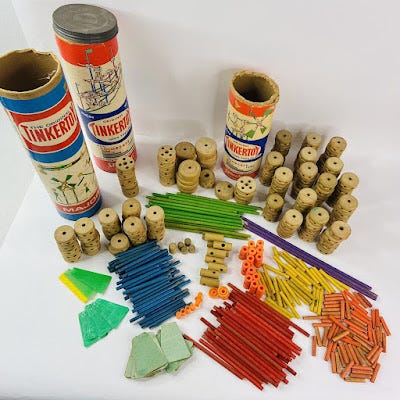Tinkertoys, Lincoln Logs and Other Building Toys
Tinkertoys and Lincoln Logs have come a long way from their beginnings as simple building toys.
Tinkertoys and Lincoln Logs were among my favorite toys as a kid. I studied visual art for years, but I didn’t aspire to be an engineer or an architect. I just enjoyed the thrill of building things with my toys.
They’re still made. They rank among the oldest American-made toys on the market.
Tinkertoys
Tinkertoys were created by Charles Pajeau, a stonemason, in 1913. Seeing kids play with sticks and spoils of thread inspired him.
Among the pieces included:
sticks,
pegs,
“wheels,” like spools, with center holes
center-hole wheels with holes on the circumference,
five-holed wheels, also with holes on the circumference at 45-degree angles,
cylindrical caps with one hole,
cylindrical couplings with three holes,
pulleys, looser fitting than wheels, and
fan blades, or “flags.”
You screw the sticks into the holes of the wheels at different angles. They can form a variety of shapes, either geometric or abstract.
I don’t remember the kinds of things I made with my Tinkertoys. I probably made abstract shapes as opposed to geometric ones. That’s the artist in me.
Lincoln Logs
Abraham Lincoln was, indeed, born in a log cabin, in 1809 in Kentucky, hence the name. Other US presidents to do the same include James Buchanan, Millard Fillmore, James Garfield, Andrew Jackson, Franklin Pierce and James Polk.
Lincoln Logs were created by John Lloyd Wright, son of Frank Lloyd Wright, around 1916-17. He was an architect like his father.
The elder Wright had designed the Imperial Hotel in Tokyo, which would be finished in 1923. It had interlocking log beams, which made the structure earthquake-proof.
The younger Wright had a yen for making toys. He started a toy company, and by 1918, had marketed Lincoln Logs. It became one of the first gender-neutral toys, a part of its success.
Made of redwood (it had a nice scent), the basic design had notches in miniature logs of various sizes, which could be interlocked at right angles to form small structures resembling log cabins.
In addition, the set included:
roof slats,
chimneys,
windows, and
doors.
Later versions added animal and human figurines.
I suspect building something recognizable, namely a house, appealed a bit more to me as a kid. That may be why I feel a greater affinity with Lincoln Logs than Tinkertoys—but I liked both.
Variations and DIY versions
Both toys have evolved and inspired imitations over the years.
Tinkertoys also began made of wood, but plastic versions are also available. In the seventies there were giant Tinkertoys.
Lincoln Logs have inspired DIY versions, made out of things such as pool noodles. More industrious adults have built life-sized Lincoln Log-style cabins to live in. There’s even a McDonald’s log cabin!
As for the original toy, this website depicts an attempt to establish a world record for building a Lincoln Log cabin.
Earlier this year, the Roku channel launched a TV series called Lincoln Log Masters, in which two guys lead a crew of life-sized Lincoln Log cabin builders. Audience reaction has been positive.
Educational benefits
These days American education places a premium on STEM—science, technology, engineering and mathematics—when it comes to developing innovation and critical thinking skills in young minds. Toys play a role in that.
Tinkertoys and Lincoln Logs are considered STEM toys, especially the former. This webpage, for example, outlines making a pulley with Tinkertoys and using it as an opportunity to apply STEM concepts.
Another webpage specifies a set of skills children can learn from Tinkertoys:
fine motor/visual skills
gross motor skills
sensory skills, and
articulation/speech skills.
Other building toys
Additional building toys include:
Legos, which have enjoyed a surge of popularity in recent years,
Mega Blox, good for little kids,
K’nex, similar to Tinkertoys, and
Meccano Erector Sets, good for making buildings, conveyances, even robots.
Good Housekeeping lists the best building toys for 2023, most of which have STEM benefits.
Writing this post has made me miss such toys. They probably contributed to my artistic growth in some fashion.
They were fun, too.
@byrichwatson
———————-
Did you play with Tinkertoys or Lincoln Logs?





